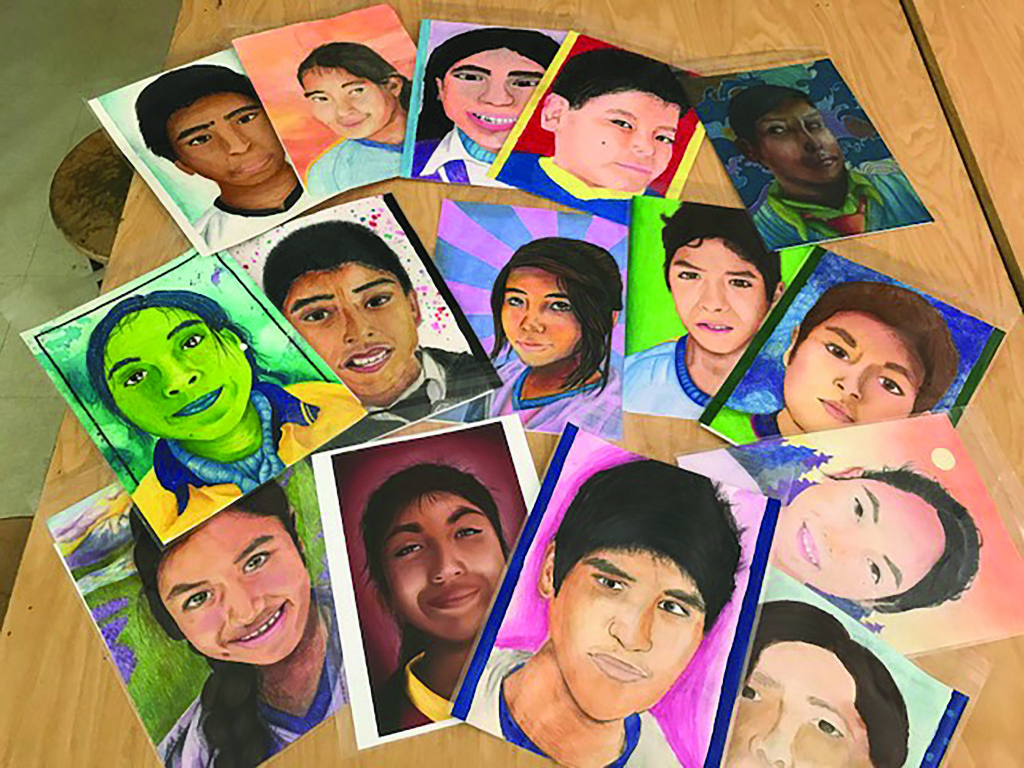
What is the Memory Project? It is a charitable nonprofit organization that invites art teachers and their students to create and donate portraits to youth around the world who have faced substantial challenges, such as neglect, abuse, loss of parents, violence and extreme poverty.
Memory Project Notes: Bolivia 2017 by Jennifer French
As a teacher, I have participated in the Memory Project before. This year I decided to involve my Art IV Honors students and two Independent Study students at Holly Springs High School. I knew this project would engage my students and allow them the opportunity to use a variety of media and creatively practice kindness and global awareness. There are many types of art and many reasons for making it. This project emphasized using art as a language. We overcame the language barrier and touched the hearts of children from another country (as well as our own) without the need of using any words. For example, some of the children said the following about their portraits they received from us, “It expresses what I feel,” “They are from the heart,” “It really captures me, I love it!” Some of the adults who help operate the residential homes and schools also said the following, “They’ll look at these later in life and you’ll still be in their thoughts,” “This will be a memory for a lifetime.” I, personally, feel the same is true for my students. They, too, will cherish this process and children that they created portraits for.
There was a 15$ fee for each portrait that our principal, Mr. Pittman, graciously covered. This fee went towards the delivery of the portraits and the remaining money was donated to the residential schools in Bolivia for the kids.
The Memory Project organization provided us with 4 or 5 countries to choose from. We chose Bolivia because the dates for delivery to this country fit within my curriculum and our spring calendar the best.
To do this project, we received photos of children and teens from global charities operating residential schools in Bolivia. These photos also included the child’s name and favorite color which allowed us to know a little more about each of them.
I shared short videos from Memoryproject.org with my students to help explain the process. While working on our portraits, we watched short videos about Bolivia so that students could get a better idea of the culture there.
We started this project in March of this year and spent several weeks on it. In their art class, students were asked to draw or paint a 9 x 12 portrait of a Bolivian orphan. Students engaged in the creation of their art and they were also used as a vehicle to spread global outreach. It allowed students to connect their world with that of another. It gave students the opportunity to change someone’s life and leave a lasting impression.
Some students chose to use colored pencils as their media, some chose acrylic paint or watercolor paint, and one chose to do a digital painting on their iPad. They were encouraged to incorporate the child’s favorite color while changing the clothing and adding creativity in the background as needed. The first section of the video shows the students throughout their creative process.
Our students have such big hearts. They were genuinely interested in the lives of these kids and referred to them by their first name daily. Amanda Falchi, a junior at HSHS, couldn’t wait to work on her portrait of Tito each day. My students didn’t want to do anything less than their very best. This was a challenging project and forced students to draw realistically yet also creatively. Students struggled on occasion but pulled through by problem solving with their media of choice and by collaborating with me and their classmates. We were all in this together.
Upon finishing the portraits, students added a photo of themselves and included their name so the children in Bolivia would know who the artist was. Both the art and the artist information was then placed in a clear protective sleeve for safe keeping.
The portraits were delivered to Bolivia in early April. I mailed them to the Memory Project the last week of March and they then hand delivered them.